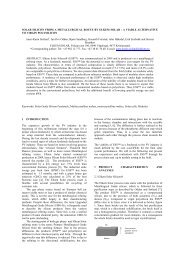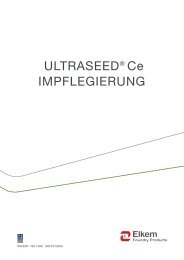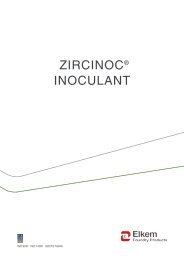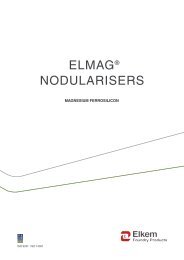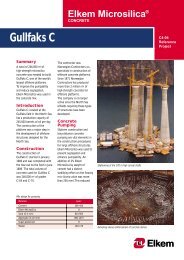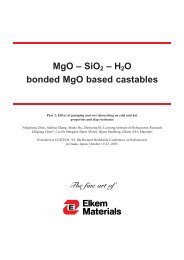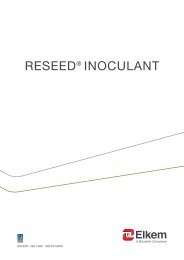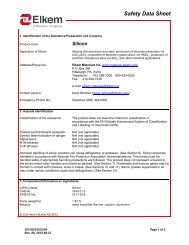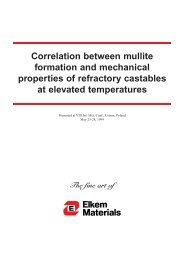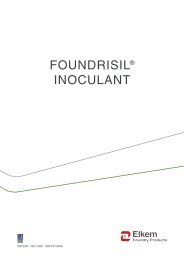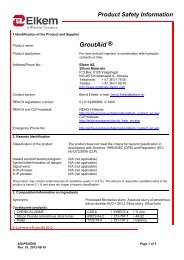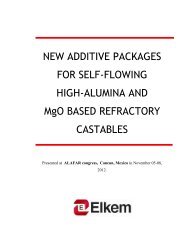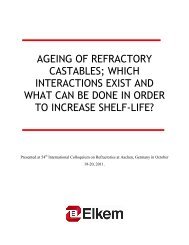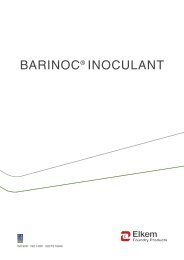You also want an ePaper? Increase the reach of your titles
YUMPU automatically turns print PDFs into web optimized ePapers that Google loves.
65wt% cement. Or said in other words; a castable with less than 3.5wt% microsilica at<br />
6.5wt% cement will start to dissolve mullite when it is heated.<br />
One important corollary that may be found in the phase diagram is connected to the peritectic<br />
at 1512°C, located close to the composition of Anorthite. Basic knowledge of phase diagrams<br />
and crystallization paths tells us that if we have a liquid with a composition within the<br />
compatibility triangle Corundum-Anorthite-<strong>Mullite</strong> (e.g. a molten castable) and cool it, then:<br />
1) Corundum precipitates and the composition of the remaining liquid moves away from<br />
corundum, until 2) mullite starts precipitating and, 3) the last liquid disappears at 1512°C at<br />
the peritectic composition.<br />
For the formation of mullite in a castable, the following reaction pattern has been suggested 6 :<br />
Initially all microsilica and cement, possibly with some alumina, create a liquid<br />
supersaturated in silica at temperatures from approximately 1300°C. The supersaturated liquid<br />
crystallizes mullite until a stable composition is attained. This stable liquid has the peritectic<br />
composition. One may add to this that upon heating, to 1512°C, the mullite is stable in this<br />
environment, after which the mullite starts to dissolve in an opposite pattern as the<br />
crystallization described above.<br />
Such a peritectic liquid has been detected both directly 5,6 and indirectly 7 in castables with<br />
mullite formation.<br />
The existence of a liquid from which mullite forms is not only found in cement containing<br />
systems, it is also a consequence of the meta-stable binary system shown in Figure 1. The<br />
mullite formation is seen in Figure 2 as the strengthening of the castable with time.<br />
Practical consequences:<br />
Since the phase diagram indicates that we should expect a stable (more or less) liquid that<br />
contains calcia, silica and alumina (15wt%CaO, 48wt%SiO2, 37wt%Al2O3), and that the<br />
microsilica and cement react to form the origin of this liquid, we cannot expect that mullite<br />
will be expelled unless there is an excess of microsilica. I.e. in a LCC with 6wt% CA cement<br />
(70wt%A, 30wt%C), more than 5.7wt% microsilica is bound up in the peritectic liquid. If<br />
6wt% microsilica was used in the castable, less than 1wt% mullite should be expected in the<br />
final refractory, and total softening should commence below 1500°C on heating. More<br />
microsilica gives proportionally more mullite and better strength should be expected.<br />
It should be emphasized that it is not only the stability of mullite that matters. Since the<br />
mullite is expelled from a liquid, the amount of residual liquid is important. To strengthen the<br />
castable, each mullite crystal must connect two or more aggregate grains. With more residual<br />
liquid more mullite is needed, and the stronger is the influence of increased temperature. A<br />
powerful tool to overcome some of these problems is to reduce the level of cement, as will be<br />
seen in the following section.<br />
5 U. Schuhmacher: Untersuchungen an zementarmen und ultrazementarmen Korundfeuerbetonen. Dr. Ing.<br />
thesis, Rheinish-Westfälishen Technishen Hochschule Aachen, Germany 1988.<br />
6 B. Myhre, "Hot Strength and Bond-Phase Reactions in Low and Ultralow-cement castables" in<br />
Proceedings of UNITECR´93, Oct. 31 - Nov. 3 1993 Sao Paulo, Brazil p. 583-94<br />
7 B. Myhre, A.M. Hundere, H. Feldborg, C. Ødegård:” Correlation between mullite formation and<br />
mechanical properties of refractory castables at elevated temperatures” Presented at VIII Int. Met. Conf.<br />
Ustron, Poland. May 25-28, 1999<br />
<strong>Elkem</strong> Materials – page 5



